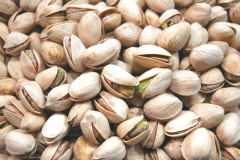Pistachio nuts
| Infobox on Pistachio nuts | |
|---|---|
| Example of Pistachio nuts |  |
| Facts | |
| Origin | - |
| Stowage factor (in m3/t) | - |
| Humidity / moisture |
|
| Oil content | - |
| Ventilation | See text |
| Risk factors | See text |
Pistachio nuts
Description
The pistachio, a member of the cashew family, is a small tree originally from Central Asia and the Middle East. Nowadays pistachio trees can be found in regions of Iran, Syria, Lebanon, Turkey, Greece, Tunisia, Kyrgyzstan, Tajikistan, Turkmenistan, India, Pakistan, Egypt, Italy (Sicily), Uzbekistan, Afghanistan (especially in the provinces of Samangan and Badghis), and the United States, specifically in California. The tree produces a seed.
Pistachio is a desert plant, and is highly tolerant of saline soil. It has been reported to grow well when irrigated with water having 3,000–4,000 ppm of soluble salts. Pistachio trees are fairly hardy in the right conditions, and can survive temperatures ranging between −10 °C in winter and 48 °C in summer. They need a sunny position and well-drained soil. Pistachio trees do poorly in conditions of high humidity, and are susceptible to root rot in winter if they get too much water and the soil is not sufficiently free-draining. Long, hot summers are required for proper ripening of the fruit.
The bush grows up to 10 metres tall. It has deciduous pinnate leaves 10–20 centimeters long. The plants are dioecious, with separate male and female trees. The flowers are apetalous and unisexual, and borne in panicles.
The fruit is a drupe, containing an elongated seed, which is the edible portion. The seed, commonly thought of as a nut, is a culinary nut, not a botanical nut. The fruit has a hard, whitish exterior shell. The seed has a mauvish skin and light green flesh, with a distinctive flavour. When the fruit ripens, the shell changes from green to an autumnal yellow/red, and abruptly splits part way open. This is known as dehiscence, and happens with an audible pop. The splitting open is a trait that has been selected by humans. Commercial cultivars vary in how consistently they split open.
Each pistachio tree averages around 50 kg of seeds, or around 50,000, every two years.
The shell of the pistachio is naturally a beige colour, but it is sometimes dyed red or green in commercial pistachios. Originally, dye was applied by importers to hide stains on the shells caused when the seeds were picked by hand. Most pistachios are now picked by machine and the shells remain unstained, making dyeing unnecessary except to meet ingrained consumer expectations. Roasted pistachio seeds can be artificially turned red if they are marinated prior to roasting in a salt and strawberry marinade, or salt and citrus salts.
Like other members of the Anacardiaceae family (which includes poison ivy, sumac, mango, and cashew), pistachios contain urushiol, an irritant that can cause allergic reactions.
Iran, the United States and Turkey are the major producers of pistachios. The trees are planted in orchards, and take approximately seven to ten years to reach significant production. Production is alternate bearing or biennial bearing, meaning the harvest is heavier in alternate years. Peak production is reached at approximately 20 years. Trees are usually pruned to size to make the harvest easier. One male tree produces enough pollen for eight to twelve drupe-bearing females. Harvesting in the United States and in Greece is often accomplished by using shaking equipment to shake the drupes off the tree. After hulling and drying, pistachios are sorted according to open mouth and closed mouth shell. Sun drying has been found to be the best method of drying. Then they are roasted or processed by special machines to produce pistachio kernels.
Pistachio trees are vulnerable to a wide variety of diseases (see list of pistachio diseases). Among these is infection by the fungus Botryosphaeria, which causes panicle and shoot blight (i.e., kills flowers and young shoots), and can damage entire pistachio orchards.
Shipment / Storage / Risk factors
Pistachio nuts are often shipped in cartons. Used in confectionery; oil is also extracted which is used as a flavouring. Contact with water or moisture may cause a change in taste and quality. Liable to infestation or exposure to heat; exposure to sun will cause dryness and a change in taste. When stored for long periods of time without adequate ventilation the nuts will deteriorate, giving off a strong odour.
Bulk container shipments of pistachio kernels are prone to self-heating and spontaneous combustion because of their high fat (45 - 55%) and low water content.
Acceptable pistachio nuts must be of sound average quality, dry, predominantly greenish (old nuts are often of a yellowish color), contain no dust or foreign admixtures and have their characteristic odour and flavour. 95 - 98% of nuts in their shell must be open. Pistachio nuts from the previous year's harvest have a tendency to beetle infestation and rancidity.
Recommended ventilation conditions for pistachio nuts are an air exchange rate of at least 10 changes/hour (airing).
Airtight packaging is ideal because pistachio kernels readily absorb moisture from the air, so becoming limp and because oxygen promotes rancidity.
Roasted and salted nuts may be stored under cool, well ventilated and dry conditions for up to three weeks and for a little longer in winter. If the maximum duration of storage is exceeded, quality may be impaired, e.g. loss of the brilliant green color and rancidity.
See also Nuts and Kernels











